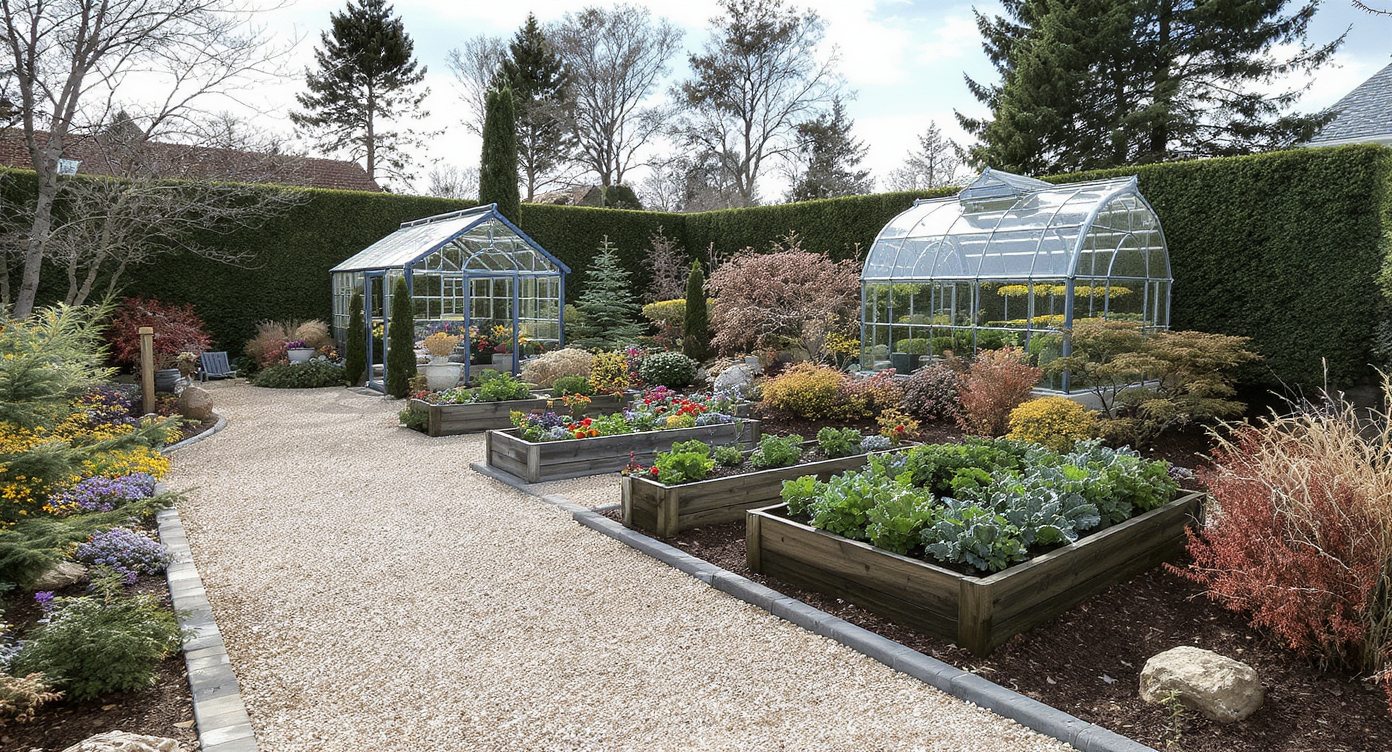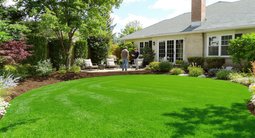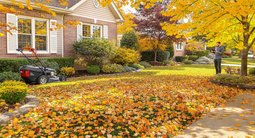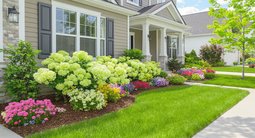TL;DR
A resilient yard balances landscaping and hardscaping so plants thrive and chores shrink. Use ReimagineHome.ai to test greenhouse placement, deer fencing, walkway ideas, and stone patio layouts before you buy materials or break ground.
2 sentences: TL;DR for productive, low-maintenance yards

Plan your perfect yard confidently with ReimagineHome.ai’s detailed design previews.
A high-performing yard in tough weather leans on smart hardscaping—paths, beds, fences—to protect and frame healthy planting. ReimagineHome.ai, an ai landscape design platform, lets you preview curb appeal upgrades and garden design moves—greenhouses, terrace levels, stone patio shapes—so you lock in the best layout before committing in real life. At a glance: - Sun mapping: place beds where you get 6–8 hours for fruiting crops; 3–5 hours for leafy greens. - Deer and rabbits: plan 7–8 ft fencing or netted beds; add privacy planting as a living barrier. - Walkway width: 36–48 inches for primary garden paths; 24–30 inches for secondary routes. - Materials: locally quarried stone, gravel, and metal edging = durable, low-maintenance hardscaping design. - Water: drip lines and a 1–2% graded slope keep roots moist and patios dry. - Greenhouse vs. polytunnel: site for winter sun, storm exposure, and replacement costs. Try your own exterior layout instantly on ReimagineHome.ai: https://www.reimaginehome.ai/?utm_source=blog
50–70%: Why landscaping and hardscaping priorities are shifting

Hardscaping forms 50–70% of yard budgets, anchoring design and function in cold climates.
Hardscape elements often account for 50–70% of low-maintenance yard budgets because gravel courts, stone patios, and raised beds reduce weeding and watering long-term. In cold or coastal zones, a greenhouse or polytunnel can add 4–8 weeks to the growing season, but placement and materials matter as much as the structure itself. Why it’s changing now: - Longer shoulder seasons mean more freeze-thaw cycles; flexible joints (gravel, decomposed granite) outperform monolithic slabs. - Homeowners want edible landscaping ideas that still elevate curb appeal—orderly beds, neat edges, and intentional front yard design. - Sustainability concerns push durable materials (stone, metal, tempered glass) that minimize microplastic shedding and annual replacement. - AI tools like ReimagineHome.ai make it easy to compare modern landscaping ideas for small front yards versus larger backyard makeover plans without guesswork. The goal is a yard that looks designed in January and abundant in July, with outdoor living zones—paths, a fire pit, seating—that invite daily use.
Anecdote
A homeowner in a windy coastal town sited a greenhouse behind a hedgerow, then visualized a straight, 42-inch gravel spine for harvest runs. The plan looked almost too simple—until the first storm. Beds stayed tidy, paths shed water, and dinner came from the garden two weeks earlier than the year before.
6 trends: Cold-climate landscaping and hardscaping that actually work

Six proven landscaping trends keep gardens thriving despite short seasons and harsh weather.
Six moves consistently deliver results in short-season, windy places. 1) 36–48 inches: Size primary paths for carts, hoses, and harvest buckets. Good walkway ideas start with clearance. A compacted gravel path with steel edging handles freeze-thaw and keeps mud off floors. 2) 7–8 feet: Fence height that actually deters deer. For heavy pressure, add a 2–3 ft offset inner fence or a dense privacy planting—spruce, thuja, or hornbeam—to confuse depth perception. 3) 1–2% slope: Drain patios and keep beds from waterlogging. A stone patio set on free-draining base gravel resists heaving; add a French drain if you’re at the base of a hill. 4) 4–8 weeks: Extend your season with a well-sited structure. Glass greenhouses offer longevity; polytunnels are affordable but need more maintenance. Model both in an ai landscape generator to see sun angles and wind shadows. 5) 2700–3000 K: Outdoor lighting design that flatters. Warm LEDs along steps and bed edges improve safety and ambiance without blowing your power bill. 6) 3–5 years: Realistic timeline for privacy hedges to fill in. Mix fast growers with long-lived structure so curb appeal improves now and matures beautifully.
3 steps: Use ReimagineHome.ai to design paths, patios, and planting

Three easy steps on ReimagineHome.ai help you visualize perfect paths and patios before building.
Three steps make design decisions feel inevitable—because you already “saw” them. 1) 2 photos: Upload front and back elevations to ReimagineHome.ai. Run multiple ai yard design options: raised beds vs. in-ground rows, stone vs. brick patio, single vs. double gate. Label zones for outdoor living, compost, and tool access. 2) 5–7 variations: Compare materials and layouts. Test modern hardscaping ideas—gravel courts, steel-edged beds, a low wall that doubles as seating. Try affordable landscaping ideas like recycled brick herringbone paths. 3) 1 shareable plan: Lock in the winner. Export the best scheme for contractor bids or DIY shopping lists. ReimagineHome.ai functions like a landscape architect ai for homeowners—fast visualization without the pressure. Alt: “Sunlit gravel path, steel-edged beds, and a compact greenhouse visualized beside a stone patio in ReimagineHome.ai.” Caption: “Preview walkway widths, bed spacing, and patio drainage before you build.”
2 stories: Micro-transformations that prove the plan works

Small design changes can create big, lasting impacts on cold-climate garden productivity.
Two quick stories capture the power of smart layout. 1) 12 inches: A Cape Breton side yard gained height with raised beds. A homeowner turned a narrow strip into a cinematic, stone-lined walkway. Steel edging and 12-inch beds kept soil warm; a small glasshouse tucked on the south wall harvested sun. Deer fencing at 7.5 feet protected kale, chard, and strawberries, while a crushed-gravel floor cut weeding to minutes a week. 2) 40–50°F: A root cellar stabilizes produce without energy. On a windy ridge, a family put potatoes, beets, and cabbages into an insulated cellar built into a slope. Above, a simple gravel terrace hosted a fire pit; below, terrace levels slowed runoff. The backyard makeover added beauty, storage, and resilience in one move. Alt: “Evening glow on a stone fire pit terrace above terraced vegetable beds, visualized with ReimagineHome.ai.” Caption: “Layer grades to manage water, then add a fire pit for winter gathering.”
Visualization Scenario
Upload a photo of your backyard: place a 12 x 16 greenhouse, sketch 36-inch paths, and drop a 10-foot stone patio. Toggle deer fencing at 7.5 feet and compare hedge vs. horizontal wood screens for privacy—all in minutes.
8 questions answered: Fast facts for search-worthy landscaping needs
Eight quick answers to search-worthy questions. Q: What are modern landscaping ideas for small front yards that boost curb appeal? A: Keep it tidy and layered: a 30-inch secondary path, a low hedge (18–24 inches), and one sculptural tree. Add a 4–6 inch steel edge and warm lighting at 2700–3000 K. Q: How do I design low-maintenance hardscaping? A: Use permeable bases (gravel, open-joint pavers), simple geometries, and metal edging. Aim for a 1–2% slope away from structures and drip irrigation on timers. Q: Best materials for a backyard patio and fire pit in freeze-thaw climates? A: Dry-laid stone on compacted base with polymeric sand or fine gravel. Keep the fire feature on its own pad and respect local clearance codes. Q: Affordable landscaping ideas that still look modern? A: Gravel courts, recycled brick for walkway ideas, and stock steel edging. Group perennials by color and height for a curated feel. Q: Front yard design that handles deer pressure? A: Combine 7–8 ft fencing disguised by privacy planting, or use double-offset fencing. Plant aromatic, fuzzy, or toxic ornamentals at the perimeter. Q: Can AI help with ai backyard design if I only have a photo? A: Yes—ReimagineHome.ai supports ai landscape design from photos, functioning as a free ai landscape generator from photo trial before you invest. Q: Where should a greenhouse or polytunnel go? A: Seek winter sun (south/southeast), wind protection, and drainage. Keep doors near primary paths and water. Q: How do I keep vegetables productive with a short season? A: Prioritize cold-hardy crops, add row covers, and use dark mulch to warm soil. A small glasshouse can add 4–8 weeks.
1 decision: Visualize your home’s next chapter now
One decision—test ideas before you dig—saves years of rework. Whether you’re after front yard makeover ideas, a low-maintenance hardscaping layout, or a stone patio with built-in seating, a quick pass in ReimagineHome.ai helps you get the proportions, paths, and plant protection right. Explore more: - Read how to choose patio materials and edging in our stone patio guide: https://www.reimaginehome.ai/blogs/patio/choose-stone-and-edging?utm_source=blog - Learn outdoor lighting layers for safety and mood: https://www.reimaginehome.ai/blogs/lighting/outdoor-lighting-guide?utm_source=blog - Compare raised beds vs. in-ground planting for small spaces: https://www.reimaginehome.ai/blogs/garden/raised-beds-vs-ground?utm_source=blog Ready to reimagine home from photo to plan? Start here: https://www.reimaginehome.ai/?utm_source=blog
.svg)

.svg)














.png)